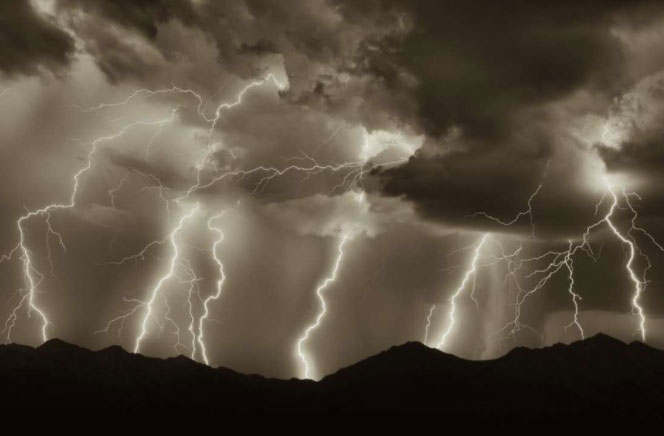Climate change causes more lightning in the Arctic
In 2021, the Arctic region saw 7,278 lightning flashes, twice as many as in the previous nine years combined. This is a rare phenomenon and the reason is attributed to climate change.
Arctic air often lacks the convective heat needed to produce lightning, so the discovery that there will be more lightning here has led scientists like Chris Vagasky, the company's meteorologist and lightning applications manager ty Vaisala, worried. He said: 'Over the past 10 years, the overall amount of lightning north of the Arctic Circle has been fairly stable. However, at the highest latitudes of the planet, lightning has increased very strongly.
With temperatures rising in the Arctic three times higher than the global average, tracking lightning in the region has become an important indicator of the climate crisis.
The three factors needed to create a thunderstorm are moisture, instability, and lift. The disappearance of sea ice means that water can evaporate more rapidly, adding more moisture to the atmosphere. Higher temperatures and atmospheric instability create perfect conditions for lightning. Therefore, monitoring changing lightning trends in the Arctic can reveal a lot about how the atmosphere is changing in response to climate change.
Mr Vagasky said: 'Changes in the Arctic could mean changes in the weather at home. Weather issues are local, but what happens at your home depends on how the air is behaving in other parts of the world. Changes to Arctic weather conditions could cause more extreme cold snaps, more heatwaves or extreme changes in precipitation in Europe."

Climate change can increase the likelihood of wildfires caused by lightning strikes.
Terrifying wildfires raged across Europe and North America last summer at least in part due to lightning strikes. Normally, less than 15% of forest fires in each year are caused by lightning, but these fires cover a larger area than those caused by humans. Identifying conditions that are favorable for wildfires caused by lightning strikes is critical to responding quickly to wildfires.
The risk of being struck by lightning in the Arctic remains low, but the increased probability of lightning could threaten communities that have not had to deal with lightning frequently in the past. People on flat tundra or oceans are susceptible to lightning strikes, and lightning puts power systems and other infrastructure at risk of damage.
Mr Vagasky said: 'Climate change can increase the likelihood of wildfires caused by lightning strikes. Scientists cannot link lightning from one day to another with changes in our climate, but monitoring lightning trends in the Arctic is crucial and needs to be studied now and in the future. future'.
According to an updated AMAP report, in less than 50 years, from 1971 to 2019, the average annual temperature in the Arctic increased by 3.1 degrees Celsius compared with the increase in the whole Earth's temperature by 1 degree. C. The report's authors say this increase is higher than previously assessed. According to the report for 2019, the average annual temperature increase in the Arctic is more than 2 times higher than the average temperature increase globally.
According to the researchers, if the Earth's temperature increases by 2 degrees Celsius, the risk of Arctic ice completely disappearing in the summer before freezing again in winter, is 10 times higher than the temperature. Earth's temperature increases by 1.5 degrees Celsius as the target set out in the 2015 Paris Agreement on climate change. The report suggests that a mostly sea-free September Arctic could happen before 2050. In the Arctic, September is usually the month with the least amount of sea ice.
The report predicts that, by the end of this century, the average temperature in the Arctic could increase by 3.3 - 10 degrees Celsius, higher than the average temperature for the period 1985-2014, with the final increase depending on the temperature. future greenhouse gas emissions.
- Climate change warms up the
- NOAA: Climate change in the Arctic is inevitable
- Summary of UN special report on climate change: The Arctic as we know it is gone, believe your eyes
- The Arctic ice color is closely linked to climate change
- The 6th China discovered the Arctic
- Giant Arctic mosquitoes thrive because of climate change
- The huge Soviet tunnel that dug into the Arctic is melting
- Other mating species makes white bears extinct
- Disaster triggered a series of terrifying nightmares on Earth
- Arctic ice is melting record fast
- Video: Dangerous germs hidden in Arctic ice are melting
- Lightning protection with laser
 Is the magnetic North Pole shift dangerous to humanity?
Is the magnetic North Pole shift dangerous to humanity? Washington legalizes the recycling of human bodies into fertilizer
Washington legalizes the recycling of human bodies into fertilizer Lightning stone - the mysterious guest
Lightning stone - the mysterious guest Stunned by the mysterious sunset, strange appearance
Stunned by the mysterious sunset, strange appearance